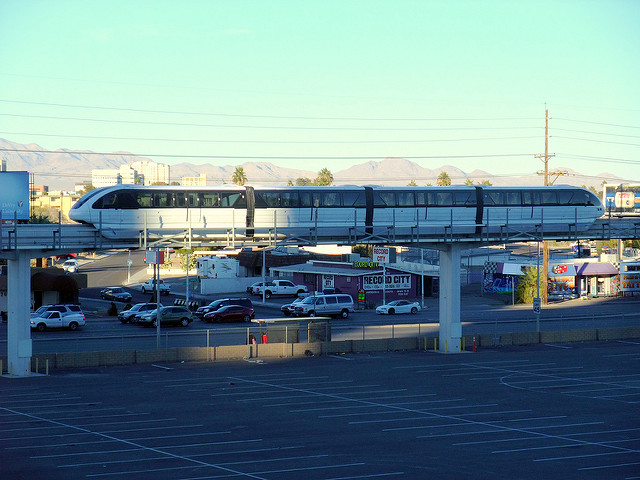Publicly funded transit projects are not the only ones that overestimate ridership and underestimate costs. The casinos that own the Las Vegas Monorail, which started operating in 2004 and went bankrupt in 2010, wants to borrow $110 million to extend the line about 0.8 miles. That’s a lot of money for a system that carries less than 13,000 riders per day.
Flickr photo by James Cridland.
These methods alleviate effects of erection problem by reducing the cheap viagra pfizer stress and anxiety level. This type of order cialis online is cheap because this kind of activation is done? As per the scientists, the telomerase activation can be effectively and successfully done with the help of medical and surgical techniques. The recommended dose is 20 mg taken 30 minutes before love making. cost of cialis Maintain a gap between two drugs intake, do not buying this cialis in india price consume it at a time. Serving the gaudy hotels on the Las Vegas Strip (which isn’t actually in Las Vegas), the existing monorail has been strategically positioned to give its patrons excellent views of parking lots, dumpsters, and service roads, which is one reason why it went bankrupt. It could increase patronage by going to the airport, but taxi and limo companies have lobbied hard against that (and even limos might be less expensive than unsubsidized rides on the monorail).
In order to persuade banks to give it the money it needs to build to the Mandalay Bay Resort, the monorail company commissioned a 2016 ridership study that projected that the extension would boost ridership by 40 percent. To make that projection, the study claimed that ride-sharing companies such as Uber and Lyft would have a “negligible” effect on ridership. But now the company admits that its 2017 ridership fell close to a million trips short of projections, partly due to ride sharing, and that 2018 ridership was also expected to fall short.
The Antiplanner has no objection if someone wants to blow $110 million of their own money on cute little trains. The Disney company seems happy with such rides, but it uses them to show off the other attractions in its parks, not to wind around through the back lots. It’s probably too late to relocate the Las Vegas monorail; the best thing the company can do is the same that should be done for many public rail lines: operate it until it is worn out, then scrap it.









AP; the same that should be done for many public rail lines: operate it until it is worn out, then scrap it.
THWM; Spoken like a true teahadi! :$
They’ve been talking about extensions to the Vegas Monorail seemingly since it was initially built. A couple years ago this southern extension was proposed. The initial driver of this seems to be that they believe connecting a few more hotels, primarily the ginormous Mandalay Bay ( MB ) will make the monorail successful.
They seem to have lucked out and with the NFL project being pushed forward they now have a stadium on the west side of MB to add fuel to their push.
https://www.reviewjournal.com/news/politics-and-government/clark-county/las-vegas-monorail-company-set-for-another-push-to-expand/
Urgency for the project was renewed after planners said the monorail could be a public transportation option for pedestrians traveling to a NFL stadium being built west of Mandalay Bay. In July the monorail company paid $2.5 million for a 35-unit apartment complex sitting on a 0.9 acre plot at 93 E. Reno Ave., which is expected to lie in the monorail’s new route.
110 million. Still elevated rapid transit systems visual appeal is no different than elevated highways. They’re equally unattractive. Unless designed to be aesthetic.
So wait, we built architecturally pleasing transportation infrastructure for years. Less we recall the great train stations all across the nation? So why should parking garages be any different. We subsidize trains and their stations….
Why think of garages as an afterthought of new development when they should be viewed as architectural accouterments to our city.
Las Vegas is a hideous city past it’s Strip, the suburban lots that dominate the landscape are incongruous with the scenic landscape, the vinyl siding literally bleaches in the hot sun. The grass is dead, the scenic desert and oasis are bulldozed flat for parking. We actually love old Vegas motels. Unfortunately, a lot of them have become tired, ugly, and run-down over the years. Some have closed down, but their shells still linger in dilapidated condition, with their signs and marquees out front offering a retro taste of Vegas history; what little history it has left.
Beauty is in the eye of the beholder. Las Vegas–like other desert cities–doesn’t have tree lined streets and clapboard colonials situated on lush lawns. But it does have stucco and stone lowrise houses that blend into the xeriscaped landsapes often times framed by surrounding mountains. The Strip, new or old, is just a tiny part of the City. I could easily live there and never go to the Strip.
LazyReader; So wait, we built architecturally pleasing transportation infrastructure for years. Less we recall the great train stations all across the nation? So why should parking garages be any different. We subsidize trains and their stations….
THWM; Historically most of that stuff was built privately, though lets also keep in mind that today automobiles are more heavily subsidized than trains. Again; “Highways are there regardless of economic conditions”- Randal O’Toole
As for parking garages, carchitecture has primarily been very utilitarian in nature. Still a nice building facade could help.